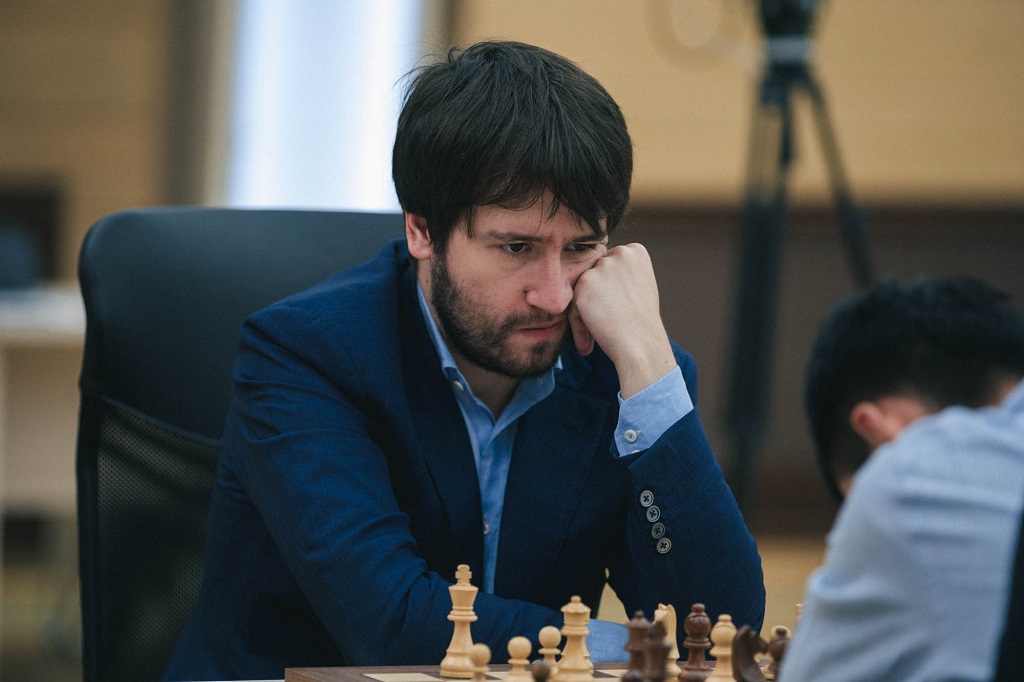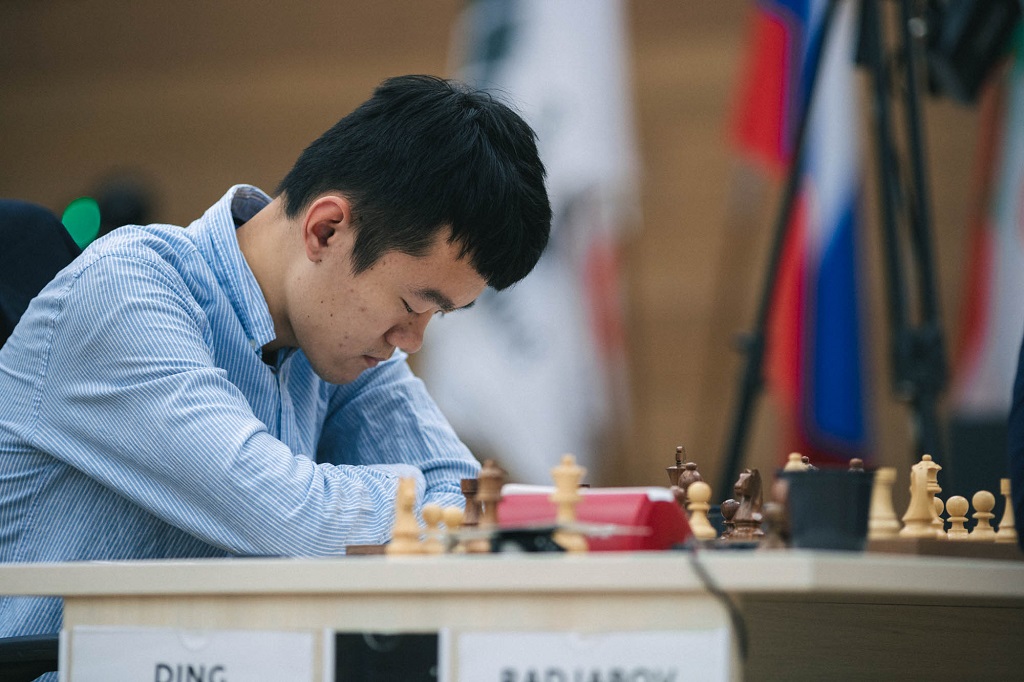


 The FIDE World Cup is taking place in Khanty-Mansiysk. It is a seven-round knock-out event for 128 players, with a total prize fund of US$ 1.6 million and a first prize of US$ 110,000. The matches consist of two classical games with a time control of 90 minutes for 40 moves plus 30 minutes for the rest of the game, with an increment of 30 seconds per move. The finals consist of four classical games. Full schedule.
The FIDE World Cup is taking place in Khanty-Mansiysk. It is a seven-round knock-out event for 128 players, with a total prize fund of US$ 1.6 million and a first prize of US$ 110,000. The matches consist of two classical games with a time control of 90 minutes for 40 moves plus 30 minutes for the rest of the game, with an increment of 30 seconds per move. The finals consist of four classical games. Full schedule.
Game one of the match for first place in Khanty-Mansiysk saw Teimour Radjabov playing a novelty on move 27 out of a Marshall Attack. The highly theoretical system was revisited in game three and, as commentator Evegny Miroshnichenko quipped, the novelty at the 21st move felt like an early deviation this time around.
After their quick draw in game one, Radjbov mentioned that he had rejected to play a different line in the Marshall, as he was not completely convinced about his chances. Now we know that he was referring to the variation he used in game three, in which a timely 22...c5 for Ding Liren would have led to a rather straightforward draw according to the Azeri.
A long-time member of the elite, Radjabov used this chance to reflect on how top-level chess is perceived by the public. He noted that if Ding had reviewed this variation deeply before the game, he would have played 22...c5 and kept things under control, in which case a number of followers would have considered Radjabov's decision as not risky enough given the tournament situation. As it was, however, the idea worked perfectly and now the score is even.
Ding Liren will have the white pieces in the last classical game of the final. Twenty-five days have gone by since the tournament started on September 10th, which means fatigue is the biggest factor in play at this point. Will the players try to get it over with on Thursday? Or will they go for a quick draw in order to save some energy before the tiebreaks?

Maxime Vachier-Lagrave and Yu Yangyi seem to be wondering if another Marshall will be seen in the match for first place | Photo: FIDE
Getting into long theoretical battles was a recurrent sight amongst the elite some ten or twenty years ago. Ever since Magnus Carlsen rose through the ranks by avoiding these struggles, however, this strategy has lost in popularity. That does not mean that the top players are not checking lines up to move 25 or 30 when the position calls for it though. Ding Liren, for example, is very well-versed in the Marshall Attack — in fact, he reached the following position twice in the past:
Ding got two draws from this position after Wesley So (Candidates, 2018) and Sergey Karjakin (Sinquefield Cup, 2019) went for 21.axb5 axb5 22.♗xd5 cxd5 here. After this sequence, So traded queens with 23.♕xf5, while Karjakin opted for 23.♖a5. What Radjabov had prepared, on the other hand, was to immediately exchange queens with 21.♕xf5 in the diagrammed position.
The game continued 21...♝xf5 22.♘e4:
Don't forget you can try your own variations on the diagram above
At this point, Ding Liren spent almost half an hour before continuing with 22...♝f8. During that long reflection, Radjabov realized that his opponent might not go for what he considered best, 22...c5. As the Azeri grandmaster declared afterwards, he can understand why Ding rejected to go for the pawn push, as some of the ensuing critical lines are quite tricky.
After the text, nonetheless, Radjabov knew the position was still drawn. A beautiful forced sequence followed — 23.♘c5 ♞b4 24.♖e5 g6 25.axb5 cxb5 26.♘e6 ♝xe6 27.♖xe6 fxe6 28.♗xe6+ ♚h7 29.♗xc8:
Undoubtedly, Radjabov had this position on his computer before the game, and he knew that Black's correct response was 29...♞c2, when after 30.♖c1 ♞xd4 31.cxd4 a5 Black has enough defensive resources. Ding opted for 29...♜xc8 instead, and went into an endgame a pawn down with a rook and a bishop per side.

Ding Liren lost a lot of ground in the clock after move 21 | Photo: FIDE
A few moves later, the commentators did not understand why Ding rejected to go for a bishop trade:
Ding played 34...♚f7 after thinking for over seven minutes, when 34...♝f8 seemed like a better try, using the maxim "all rook endgames are drawn" in his favour. It is true that a lot of work was left for Black in defence in that case as well, but what happened in the game proved this was the Chinese's best chance to keep his lead in the match.
As it was, when White managed to centralize his king, there was no way out for Ding:
Resignation came six moves later, with White about to gain a second pawn in a dominating position.
In the match for third place, Maxime Vachier-Lagrave remained loyal to the Grünfeld Defence but was the one in trouble out of the opening. Yu Yangyi demonstrated great home preparation once again, going for a sideline which allowed him to blitz out his first sixteen moves.
In hindsight, perhaps going for 16...e5 here was a better idea for Black, as after 16...exd5 White had plenty of open lines against the weakened king. Nonetheless, Vachier-Lagrave's decision to clarify the situation makes perfect sense given how tired he must feel at this point — furthermore, it is always difficult to deal with a far advanced passed pawn.
Yu was clearly the one in the driver's seat, but chose to stop the clocks rather prematurely according to the commentators — China's number two had reason enough to continue putting pressure on his opponent:
There followed 31.♕xg7+ ♚xg7 32.♘e3 and the draw was agreed. In the diagrammed position, Yu could have gone for 31.♖e1 instead, pushing his rival to find accurate defensive moves to keep the balance.

Maxime Vachier-Lagrave will have the white pieces in game four | Photo: FIDE
GM Yannick Pelletier recapped the action of the day
IM Merijn van Delft looked at Radjabov vs Ding as his Game of the Week
Commentary by IM Anna Rudolf and GM Evgeny Miroshnichenko